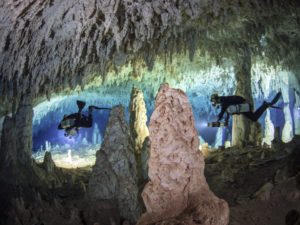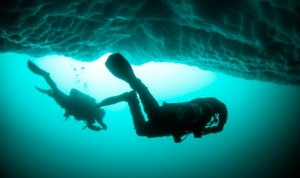“Water does not resist. Water flows. … Water is not a solid wall, it will not stop you. But water always goes where it wants to go, and nothing in the end can stand against it. … Remember you are half water. If you can’t go through an obstacle, go around it. Water does.”
― The Penelopiad
Where water goes, Jill Heinerth goes. She has donned her tanks, picked up her expensive camera and has swum into the cracks and crevices of the earth following the flowing water.
She is a cave diver, one of the most accomplished. She’s done expeditions that have landed her gigs with PBS, National Geographic and the BBC. She has been in caves and deep grottos around the world and also close to her home in Carleton Place.
Now her adventures have been captured in a memoir of one amazing journey into darkness after another.
The book opens with an anecdote about her trip into the B-15 iceberg, the largest ever, that had just calved off an Antarctic ice sheet and was bobbing in the southern ocean.
“My creative colleague (Wes Skiles) and I had decided we wanted to pitch a project on Antarctica to National Geographic. At the time we were reading all the exploration literature and thinking a lot about (Sir Ernest) Shackleton.

Jill Heinerth. Photo: Jackie Windh
“We were thinking about a movie or a story that would recognize him. Then the largest iceberg in recorded history calves and we both realized that was the story.
“We went, ‘We’re cave divers let’s go cave diving. Let’s be the first people inside an iceberg’.”
They pitched the idea with great confidence and went.
“It was also a really early look at global climate change,” she said. This was in 2001 and, she said, “people were pulling me aside and saying you can’t use terms like that.”
It was barely on people’s radar then, she said. That’s Jill Heinerth … always the early bird.
These days she is running around on the book tour of her memoir Into the Planet. The last time she was underwater was a few weeks ago.
This aquawoman never gets claustrophobic, she said. Nor does she get agoraphobic. She doesn’t like crowded highways though. She likes to control her environment.
“I really like small, cozy spaces. I was the little kid who built a fort inside a kitchen cupboard.”
She was then, and is now, a water baby.
“That is my element. I was always playing in or on the water.”
Her childhood was full of canoe trips and other outdoor activities but at school, she writes in the memoir, she was picked on.
“I’m sure a lot of kids go through that.”

“The caves are so abstract to people but, in reality, I am swimming through your drinking water. “Jill Heinerth photographed a National Geographic dive team in the cave under Abaco, Bahamas.
Part of her purpose in writing her memoir is to say to young people that they can get past that bullying.
“In many ways, I am still that little kid in kindergarten doing show and tell. I love to go to places where nobody has ever been before. But it’s no good if I keep it to myself. It is fun to show that to other people. I am a teacher in that way.
“I definitely, in all my work, try extremely hard to be the person that I wish I had met when I was 10 years old. Someone who would say ‘You know what? You can do anything you can put your minds to. Don’t let anyone stop you and tell you you can or not’.”
She still uses a Florida area code because her U.S. cell phone plan is much cheaper. But she loves Carleton Place.
“It’s great small town on the Trans Canada Trail. I’m in an old mill building and I have the river in my backyard. It’s very close to Ottawa and just steps from the outdoor environment I love.”
It’s that passion that has taken her around, under and through the world.
She is the type to climb every mountain, and swim into every cave just because they are there. But there is this larger context.
“I feel like I’m a canary in a coal mine in many ways. The caves are so abstract to people but, in reality, I am swimming through your drinking water. And I have an opportunity to talk to people and get them really excited about exploration.
“I tell them about the magical places I have been and when their jaws are agape, I get to shove a little truth in about water literacy — where our water comes from. How we might be unintentionally over-using it or damaging the quality and how to protect this resource for next generation.
It’s the same thing about climate change, she said. As I travel to the north, I have my eyes open to the environment and I can communicate changes I am seeing.”
She’s done a movie called movie called We Are Water about water literacy and that included a look at ‘fracking’ for oil.
“When I first drove to the birthplace of fracking in the U.S., Dimock, Pennsylvania, I remember driving down a hill into a basin in the town and there were for sale signs up on every single house and the whole community smelled like a natural gas leak. If I didn’t know it was a fracking place I would have called 911.
“This hunt for cheaper oil is destroying drinking water. There will be a lot of regrets on this one.”
Heinerth sees all our bad decisions about the water we need for life because she swims through them.

Jill Heinerth has also dived to shipwrecks off Bell Island Newfoundland.
In many ways, she reminds me of one of the heroes of Jules Verne’s novel Journey to the Center of the Earth. It is kind of freaky to think of her swimming way down underneath a grotto and looking up to see people frolicking on the surface of the water.
When Heinerth is down below, sliding through a narrow passage, she’s all business.
“I am as focussed as one can be when I am dealing with some sort of scientific mission. I manage my life support and operate my camera. It’s a dance between my right brain and my left brain. It’s not lost on me that this is a very primal kind of experience.
“Like I say, I am swimming in the veins of Mother Earth. It’s almost that spiritual return to the womb, … but I’m pretty darned focussed.”
Heinerth is good at communicating an image. She says, “we have all the water that we are ever going to have on the planet. We just keep reusing it in one way or another. That means I might be swimming through Shakespeare’s tears. It’s all connected.”
To do her work, she pitches her ideas and hopefully gets hired. Other times she does something and tries to sell an article or a film after the fact.
It’s definitely not a cheap profession. her gear alone is worth thousands.
“It’s almost impossible to put a number on some things.”
She did a major mapping project in the late ’90s and basically built the device. That’s now been developed through four generations and she says that NASA will use it on a future mission to Jupiter’s moon Europa.
“How much is that worth? What kind of a price tag could you put on thousands of volunteer hours?”
She has a couple of projects on the go right now.

Exploring icebergs off Newfoundland. Photo: Jill Heinerth
“I have a couple of shipwrecks; I’m continuing to work with Bob Ballard and National Geographic in California and then I’m working with a scientist from the Museum of Nature in Ottawa on fresh water mussels in the Ottawa River.
Andre Martel is the expert on molluscs and he’s reached out to Heinerth because some intriguing endangered mussels have been found in an underwater cave in the Ottawa River.
“We are just starting to work together. I’m going to photograph and document these endangered species for him and I will re-survey the cave system and potentially do some work on mussels inside the cave. I’ll be his eyes and hands.”
The cave system is near West Meath, in the Pembroke area, and it contains 10 kilometres of underwater cave passages.
“For me, this is a volunteer effort. I’m sure I’ll write some articles. He’ll write for a scientific paper. That’s how a lot of my work happens but I don’t know if this will make money. But the work interests me and I imagine we’ll turn it into something.”
Into the Planet: My Life as a Cave Diver by Jill Heinerth (Doubleday Canada).







